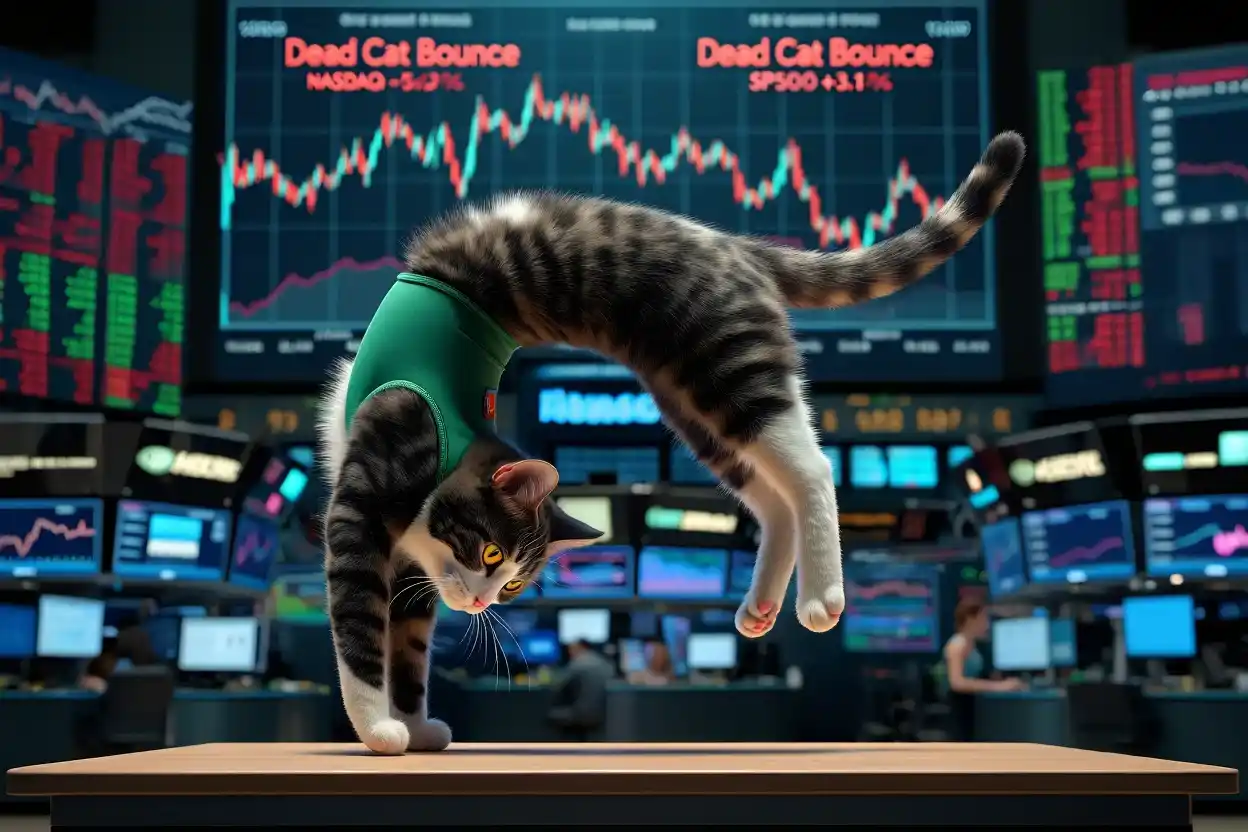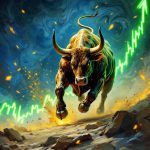Dead Cats Bounce: Wall Street’s Favorite Zombie Gymnastics Routine
April 17, 2025
The Concrete Kiss
It begins not with a whisper, but a sickening thud. The sound of value impacting reality at terminal velocity. A stock, a sector, an entire market, plummeting—a dizzying descent from grace, shedding points like feathers in a hurricane. Panic paints the tape crimson. Fear, raw and primal, grips the collective consciousness. Margin calls sing their siren song of ruin. The air crackles with the ozone of evaporating wealth.
Fortunes built over the years vanish in hours, leaving behind the acrid scent of burnt capital and shattered confidence. This isn’t merely a correction; it’s a purge, a violent expulsion of excess, a gravitational reckoning. The asset lies broken, seemingly lifeless on the pavement of price charts. The crowd disperses, muttering curses or prayers, convinced the worst is over, or perhaps, just beginning. The silence that follows is heavy, pregnant with the potential for further collapse. But then, something stirs. A flicker. An anomaly.
Echoes in the Abyss
Wall Street, in its infinite capacity for brutal poetry, has a name for this phenomenon: the Dead Cat Bounce. The phrase itself is a masterpiece of gallows humour, conjuring the image of feline mortality defying physics for one last, grotesque spasm. “Even a dead cat will bounce,” the old traders rasp, “if dropped from a high enough height.” It’s crude, visceral, and chillingly accurate.
This isn’t resurrection; it’s reflex. A momentary, deceptive surge in the price of a fundamentally broken asset, an echo reverberating in the abyss left by the crash. It is the market’s phantom limb, twitching with the memory of upward momentum. It is an illusion masquerading as recovery, a siren’s call to the unwary, promising safe harbour on shores that are already crumbling into the sea. This is not a sign of life returning; it is the final, convulsive shudder before the rigour mortis of a sustained downtrend truly sets in. It is Wall Street’s favourite zombie gymnastics routine, performed on the graveyard of broken trends.
The Quantum Twitch
What animates this corpse? What force compels the dead to dance briefly? The mechanics are a confluence of desperation and opportunism, a fleeting disturbance in the market’s quantum field. Firstly, consider the short sellers – those who profited from the decline. As the price hits a perceived bottom or pauses its free fall, some rush to cover their positions, buying back shares to lock in gains. This sudden influx of buy orders creates artificial demand, a brief upward pressure. Think of it as reversing polarity for a microsecond – the negative charge momentarily flipping positive.
Simultaneously, the bargain hunters emerge from the wreckage. These are the hopeful, the contrarians, the players who mistake a catastrophic injury for a temporary setback. They see the drastically lower price not as a warning, but as an invitation – a “discount.” Their buying adds fuel to the nascent flicker, amplifying the signal. Technical traders, too, play their part. They observe the price hitting historical support levels, or certain indicators flashing “oversold.” Their algorithms and pre-set buy orders trigger, adding another layer of demand.
It’s a moment of profound uncertainty, akin to the observer effect in quantum physics. The very act of watching and reacting to the price stabilisation momentarily alters its trajectory. For a brief moment, the asset exists in a superposition of states, potentially recovering or resuming its plunge. However, unlike the quantum realm, where possibilities linger, the market’s underlying reality—the reason for the initial collapse—exerts an overwhelming gravitational pull. The bounce is merely a probabilistic anomaly, a temporary deviation from the most likely path: further decline. It’s a twitch, not a turnaround.
Necrotic Alchemy
The true dark magic of the Dead Cat Bounce lies not in the charts but in the crucible of human psychology. It is a masterclass in necrotic alchemy, transforming the base metal of fear into the fool’s gold of hope. The initial crash induces trauma, a state of shock and despair. Investors who held on through the fall are desperate for relief, for any sign that their decision wasn’t catastrophic. The bounce provides that sign. It whispers validation, suggesting their diamond hands might yet be rewarded.
Greed, fear’s insidious twin, awakens. Those who sold too early, or missed the initial plunge, now feel the sting of FOMO – Fear Of Missing Out – on the perceived recovery. “Maybe the bottom is in,” they rationalise. “Maybe this is the entry point.” The pain of the recent loss is momentarily overshadowed by the allure of recouping it quickly, of catching the mythical falling knife by the handle, not the blade.
This psychological brew is potent, unstable. It’s like a chemical reaction operating far from equilibrium – a sudden release of energy (buying pressure) driven by emotional catalysts rather than fundamental stability. Hope acts as an accelerant, burning brightly but briefly. The collective memory is short; the allure of a quick profit, intoxicating. Investors forget why the asset collapsed. Was it disastrous earnings? A failed product? A sector-wide rot? In the heat of the bounce, these inconvenient truths are momentarily suspended, replaced by the intoxicating narrative of a comeback. It is the alchemy of self-deception, turning leaden fundamentals into golden illusions.
Ghosts in the Machine
In the modern market, this macabre dance is amplified and accelerated by ghosts in the machine – high-frequency trading (HFT) algorithms and automated systems. These silicon predators detect the subtle shifts in order flow, the first flickers of a potential bounce, far faster than any human eye. They can swarm a stock, exploiting micro-price movements and adding to the buying pressure as shorts cover and technical levels are triggered.
Their participation lends the bounce a veneer of legitimacy, a surge of volume that appears to be conviction. But these algorithms are not betting on a fundamental recovery. They are momentum chasers, liquidity providers, or arbitrageurs, programmed to scalp fractions of a cent from the fleeting volatility. They are the digital jackals feasting on the carcass, amplifying the noise, making the zombie’s twitch look more like a purposeful stride.
Once the initial buying impulse fades, once the short covering is exhausted and the early bargain hunters have placed their bets, these same algorithms can reverse course with merciless speed. Detecting the waning momentum, they flip their positions, adding to the selling pressure that inevitably follows. They are catalysts, accelerating both the brief ascent and the subsequent, often brutal, resumption of the downtrend. They add a layer of complexity, a digital ghostliness to the already treacherous landscape of the Dead Cat Bounce, making it faster, sharper, and potentially more deceptive than ever before.
The Reaper’s Gambit
While the hopeful and the naive are drawn into the bounce like moths to a flickering, deadly flame, another class of trader watches with cold, calculating precision. These are the seasoned players, the cynics, the ones who understand the physics of market mortality. For them, the Dead Cat Bounce is not a sign of hope, but an opportunity – a second chance to short the asset at a more favourable price.
They recognise the bounce for what it is: an emotional spasm, a technical artefact devoid of fundamental support. They wait patiently, watching the surge exhaust itself. They look for signs of weakening momentum – declining volume, a rise in selling pressure, and failure to breach key resistance levels. Their timing is crucial, honed by experience and a deep understanding of market psychology. They are placing their bets not on resurrection, but on the immutable laws of financial gravity.
This is the Reaper’s Gambit. It requires discipline, conviction, and the nerve to bet against the fleeting optimism of the crowd. It’s about understanding that the energy needed to reverse a powerful downtrend is immense, far greater than the temporary fuel provided by short covering and bottom fishing. Shorting a Dead Cat Bounce is a high-stakes manoeuvre, requiring precise entry and risk management. Get it wrong, and the zombie might keep climbing longer than anticipated. But get it right, and the rewards are substantial, profiting from the inevitable return to reality, the second, often deeper, plunge into the abyss. It is the ultimate contrarian play, executed with the chilling precision of an assassin.
Gravity’s Embrace
Like Newton’s apple, what goes up in a Dead Cat Bounce must inevitably come down – often harder. The forces animating the bounce are temporary, artificial. The underlying issues that caused the initial collapse – poor fundamentals, negative sentiment, and structural problems – remain unresolved. Gravity, in the financial sense, reasserts its dominion.
The short covering dries up. The bargain hunters realise they’ve caught a falling anvil, not a trampoline. The technical traders see their indicators reverse. The algorithms flip from buy to sell. The brief flicker of hope extinguishes, replaced by the dawning, sickening realisation that the initial fall was not an aberration, but a prelude.
The subsequent decline is often swift and brutal. It breaks through the lows established during the bounce, confirming the strength of the downtrend. Those who bought into the bounce are trapped, facing mounting losses and the painful choice between cutting their losses or praying for another miracle. This second leg down is where the true damage is often done, shaking out the last vestiges of hope and reinforcing the asset’s pariah status. It is the market reminding everyone that physics, even financial physics, is relentless. The dead cat, having twitched, finally settles into the dust, embraced by the undeniable pull of gravity.
Beyond the Veil
The Dead Cat Bounce is more than a chart pattern; it is a recurring parable etched into the very fabric of the market. It speaks to the eternal tension between fear and greed, hope and reality. It is a testament to the power of mass psychology and the dangers of mistaking motion for progress. To navigate these treacherous waters requires more than just technical skill; it demands psychological fortitude, a healthy dose of scepticism, and the discipline to resist the siren song of easy money.
Understanding the Dead Cat Bounce is like peering behind the curtain of market mechanics, seeing the levers and pulleys that manipulate emotion and capital. It teaches us that price action, divorced from fundamental context, is merely noise, signifying nothing. It underscores the importance of independent thought, of questioning the narrative, especially when that narrative feels too good to be true after a period of intense pain.
This zombie gymnastics routine will continue to play out as long as markets exist and humans drive them. The names and tickers will change, but the pattern, rooted deep in financial physics and human nature, endures. Recognising it, understanding its mechanics, and respecting its potential for destruction is not just good trading practice; it is essential for survival. Fail to learn its lessons, and you risk becoming just another statistic, another hopeful soul crushed beneath the weight of a falling corpse, forever caught in the echo of the concrete kiss. The blade of analysis must be sharp, the mind clear, the execution precise. Only then can one hope to witness the bounce without being consumed by it.















